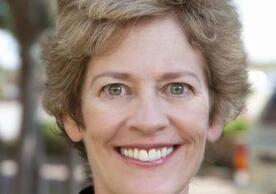
Once it became apparent that COVID-19 was an imminent threat to population health and the capacity of Connecticut’s health systems, Yale New Haven Health System (YNHHS) prepared for the inevitable surge of cases. The health system spans the Connecticut coast and encompasses Yale New Haven, Bridgeport, Greenwich, Lawrence + Memorial, and Westerly Hospitals, and Northeast Medical Group. Beth Beckman, the first chief nursing executive for YNHHS and associate dean for partnerships at Yale School of Nursing (YSN), worked to mobilize the nursing workforce, but in the middle of her work, she had to shift to organizing from home under self-quarantine. In mid-March she began to feel symptoms and tested positive for COVID-19. She was one of the first confirmed cases in the city of New Haven.
Discussing YNHHS’s response from quarantine, Beckman said that the traditional care delivery model during the COVID-19 crisis may be challenged by volume and acuity. “If we see the deluge of patients seen in other countries and even in New York, we will need to examine our care delivery model. Volume may dictate that we innovate solutions without compromising quality,” she said. “We may have to transform care delivery, working in new environments alongside nontraditional team members. If there is a need and we are in an all-hands-on-deck circumstance, we could see our talented team working in new roles on new units. Taking optimal care of patients in difficult circumstances is what we do so very well.”
Beckman pointed out that with a virus like COVID-19, “acute care is the tail end of the game.” The tip of this spear is really public health management, and “nursing should be role models for using great hand hygiene, physical distancing, and ensuring that individuals who appear sick convalesce at home. ” The Gallup Poll results for decades have validated that the public trusts and counts on nurses to support the community’s well-being. We can do this by educating the public about viral spread, how to prevent it, and self-monitoring for symptoms.” As the pandemic shifts to acute care needs, she described three main buckets of inpatient concerns: personnel, space, and supplies.
On March 16, 2020, Connecticut Governor Ned Lamont called for hospitals to increase the number of beds in anticipation of COVID-19 volume. “It is easy to manage space; you can always find space. For example, convert PACUs into ICUs and conference rooms into observation units,” Beckman said. “Supplies becomes more challenging in the face of a global epidemic. Conservation strategies for appropriate personal protective equipment (PPE) use and innovation applications like telemedicine and virtual care will be key,” she said.
“Personnel is an entirely different story,” she continued. “You can create space and provide ample supplies, but you can’t provide care without people, our most valued asset. We have to keep health care workers safe and well. It is our daily focus in all that we do.” YNHHS is already working on innovative PPE solutions, including working with YSN faculty such as Dr. Linda Honan ’89 MSN, PhD, CNS-BC, RN, ANEF, FAAN.
“If we get to that state of scarcity, nurses are remarkably good at innovation,” she said. “All the other disciplines float in and out, but nursing is there at the patient’s side twenty-four seven.” Beckman believes in creating an environment in which nurses can add their voices and share their ideas. “We have to create the opportunity for them, and then take what has been suggested to adapt quickly. Nurses know what needs to occur. Just ask them.”
Before the current COVID-19 crisis, the building blocks of a collaborative workforce across YNHHS were put into place. Beckman inherited a culture that is valued by the organization and is supported by a strong professional governance structure. Empowering nurses translates to sustainable excellence. “At YNHHS, the dyad model of nurse-physician partnering is demonstrative of empowering nurses,” Beckman said. “Additionally, we have shifted our language. Nurses are bedside leaders, not staff nurses. We must call them what they are: bedside leaders. By doing so, we recognize them for the value they bring, and call them to their highest level of contribution.” Beckman believes that “bedside leaders shouldn’t feel any less important than the chief nursing executive. It is through them that our mission, vision, and value occur.”
YNHHS is working to synchronize nursing practice, policies, governance, and recognition across its hospitals. One way in which this was achieved was in harmonizing the clinical ladder, which was structured differently in each of the hospitals; everything from administration to pay was different. Now, if a bedside leader working in Greenwich Hospital were to transfer to Yale New Haven Hospital, their clinical ladder would be recognized in the same way across settings. “YNHHS is focused on creating a broader system Care Signature so that patients, families, and health care workers have an experience that looks and feels the same and embodies a consistent emblem of excellence,” said Beckman.
Again pointing to the power of words, Beckman called out the nuanced difference between a Care Signature and a Signature of Care. A signature of care is “care happened, and you give it a signature,” she said. It is haphazard, and the care can be good or bad. Care signature, she continued, is “we decided what the care was going to be, and we imprinted it on the experience. It is predetermined. It is replicable. And it is sustainable.”
Beckman knows the YNHHS Care Signature will be tested as more patients end up in the hospitals with COVID-19. As the bedside leaders of YNHHS prepare for what is to come, the respect and admiration for their chief nursing executive is apparent. While Beckman recovered from her symptoms, some of her colleagues at Yale New Haven Hospital tweeted at her with pictures and words of encouragement, urging their leader to get well soon.
Beckman’s reply? “I am doing great, and my only worry is for your health and safety.”
